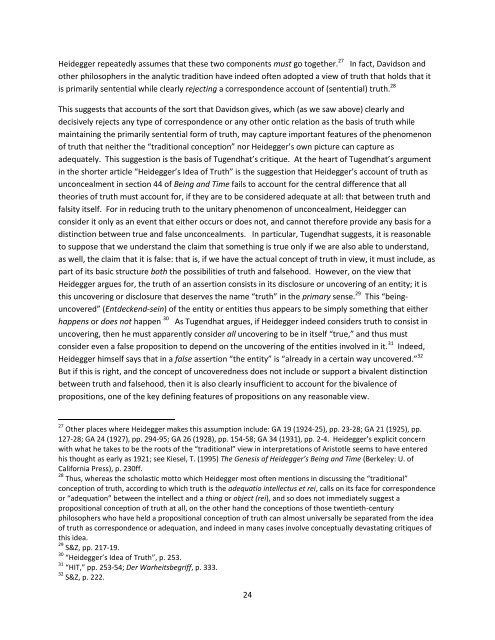Heidegger, Tugendhat, Davidson - University of New Mexico
Heidegger, Tugendhat, Davidson - University of New Mexico
Heidegger, Tugendhat, Davidson - University of New Mexico
You also want an ePaper? Increase the reach of your titles
YUMPU automatically turns print PDFs into web optimized ePapers that Google loves.
<strong>Heidegger</strong> repeatedly assumes that these two components must go together. 27 In fact, <strong>Davidson</strong> and<br />
other philosophers in the analytic tradition have indeed <strong>of</strong>ten adopted a view <strong>of</strong> truth that holds that it<br />
is primarily sentential while clearly rejecting a correspondence account <strong>of</strong> (sentential) truth. 28<br />
This suggests that accounts <strong>of</strong> the sort that <strong>Davidson</strong> gives, which (as we saw above) clearly and<br />
decisively rejects any type <strong>of</strong> correspondence or any other ontic relation as the basis <strong>of</strong> truth while<br />
maintaining the primarily sentential form <strong>of</strong> truth, may capture important features <strong>of</strong> the phenomenon<br />
<strong>of</strong> truth that neither the “traditional conception” nor <strong>Heidegger</strong>’s own picture can capture as<br />
adequately. This suggestion is the basis <strong>of</strong> <strong>Tugendhat</strong>’s critique. At the heart <strong>of</strong> <strong>Tugendhat</strong>’s argument<br />
in the shorter article “<strong>Heidegger</strong>’s Idea <strong>of</strong> Truth” is the suggestion that <strong>Heidegger</strong>’s account <strong>of</strong> truth as<br />
unconcealment in section 44 <strong>of</strong> Being and Time fails to account for the central difference that all<br />
theories <strong>of</strong> truth must account for, if they are to be considered adequate at all: that between truth and<br />
falsity itself. For in reducing truth to the unitary phenomenon <strong>of</strong> unconcealment, <strong>Heidegger</strong> can<br />
consider it only as an event that either occurs or does not, and cannot therefore provide any basis for a<br />
distinction between true and false unconcealments. In particular, <strong>Tugendhat</strong> suggests, it is reasonable<br />
to suppose that we understand the claim that something is true only if we are also able to understand,<br />
as well, the claim that it is false: that is, if we have the actual concept <strong>of</strong> truth in view, it must include, as<br />
part <strong>of</strong> its basic structure both the possibilities <strong>of</strong> truth and falsehood. However, on the view that<br />
<strong>Heidegger</strong> argues for, the truth <strong>of</strong> an assertion consists in its disclosure or uncovering <strong>of</strong> an entity; it is<br />
this uncovering or disclosure that deserves the name “truth” in the primary sense. 29 This “beinguncovered”<br />
(Entdeckend-sein) <strong>of</strong> the entity or entities thus appears to be simply something that either<br />
happens or does not happen 30 As <strong>Tugendhat</strong> argues, if <strong>Heidegger</strong> indeed considers truth to consist in<br />
uncovering, then he must apparently consider all uncovering to be in itself “true,” and thus must<br />
consider even a false proposition to depend on the uncovering <strong>of</strong> the entities involved in it. 31 Indeed,<br />
<strong>Heidegger</strong> himself says that in a false assertion “the entity” is “already in a certain way uncovered.” 32<br />
But if this is right, and the concept <strong>of</strong> uncoveredness does not include or support a bivalent distinction<br />
between truth and falsehood, then it is also clearly insufficient to account for the bivalence <strong>of</strong><br />
propositions, one <strong>of</strong> the key defining features <strong>of</strong> propositions on any reasonable view.<br />
27 Other places where <strong>Heidegger</strong> makes this assumption include: GA 19 (1924-25), pp. 23-28; GA 21 (1925), pp.<br />
127-28; GA 24 (1927), pp. 294-95; GA 26 (1928), pp. 154-58; GA 34 (1931), pp. 2-4. <strong>Heidegger</strong>’s explicit concern<br />
with what he takes to be the roots <strong>of</strong> the “traditional” view in interpretations <strong>of</strong> Aristotle seems to have entered<br />
his thought as early as 1921; see Kiesel, T. (1995) The Genesis <strong>of</strong> <strong>Heidegger</strong>’s Being and Time (Berkeley: U. <strong>of</strong><br />
California Press), p. 230ff.<br />
28 Thus, whereas the scholastic motto which <strong>Heidegger</strong> most <strong>of</strong>ten mentions in discussing the “traditional”<br />
conception <strong>of</strong> truth, according to which truth is the adequatio intellectus et rei, calls on its face for correspondence<br />
or “adequation” between the intellect and a thing or object (rei), and so does not immediately suggest a<br />
propositional conception <strong>of</strong> truth at all, on the other hand the conceptions <strong>of</strong> those twentieth-century<br />
philosophers who have held a propositional conception <strong>of</strong> truth can almost universally be separated from the idea<br />
<strong>of</strong> truth as correspondence or adequation, and indeed in many cases involve conceptually devastating critiques <strong>of</strong><br />
this idea.<br />
29 S&Z, pp. 217-19.<br />
30 “<strong>Heidegger</strong>’s Idea <strong>of</strong> Truth”, p. 253.<br />
31 “HIT,” pp. 253-54; Der Warheitsbegriff, p. 333.<br />
32 S&Z, p. 222.<br />
24
















